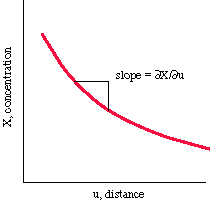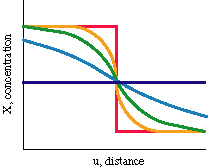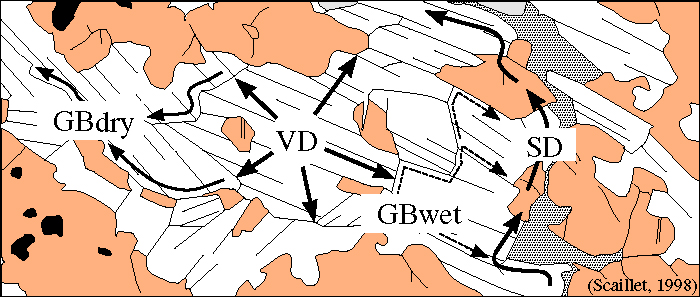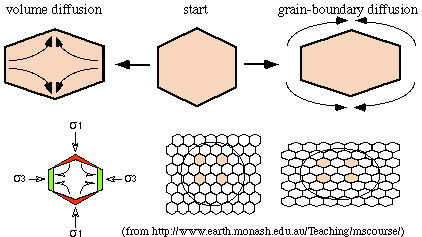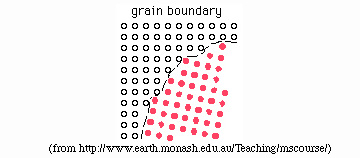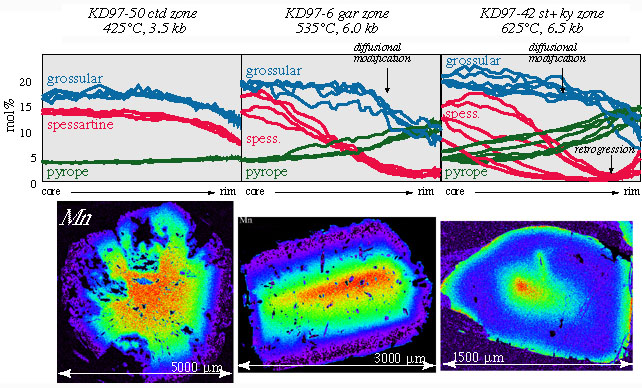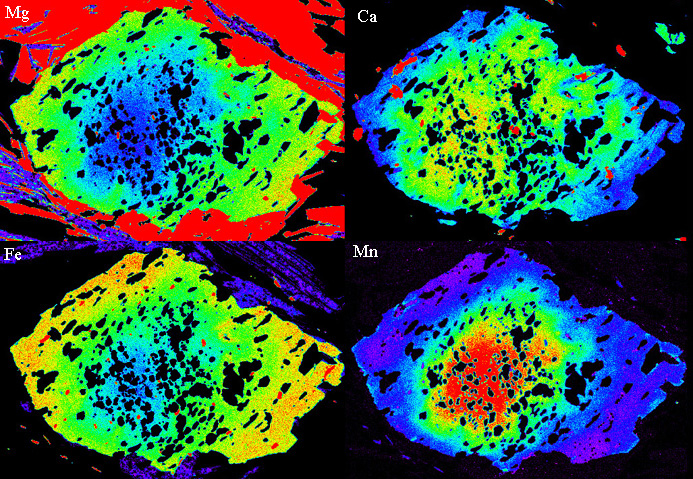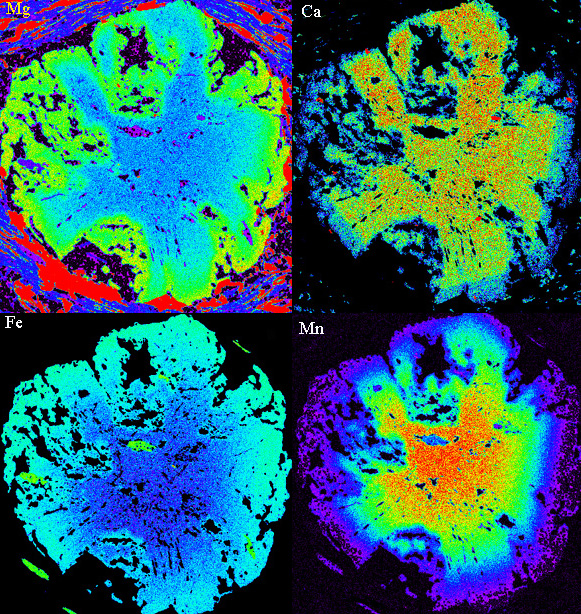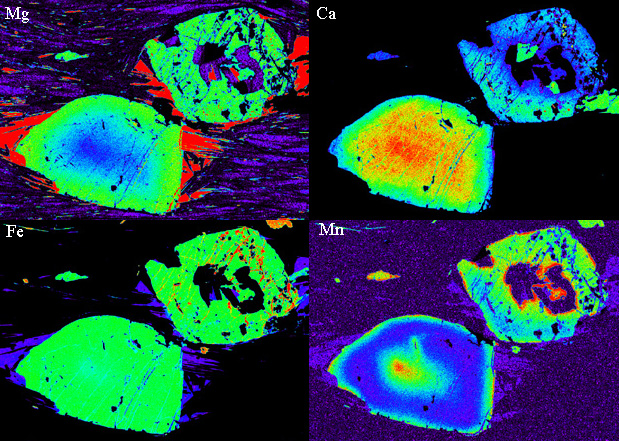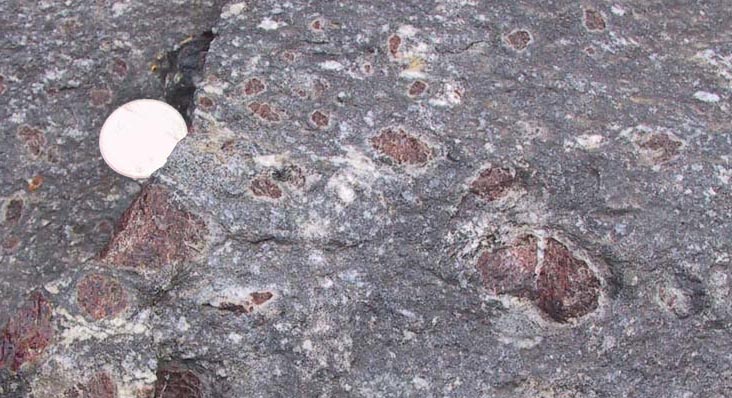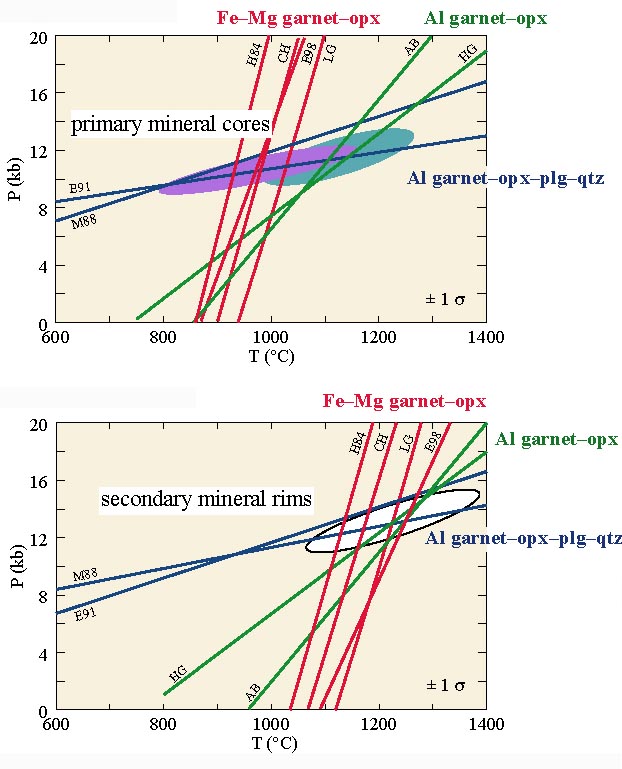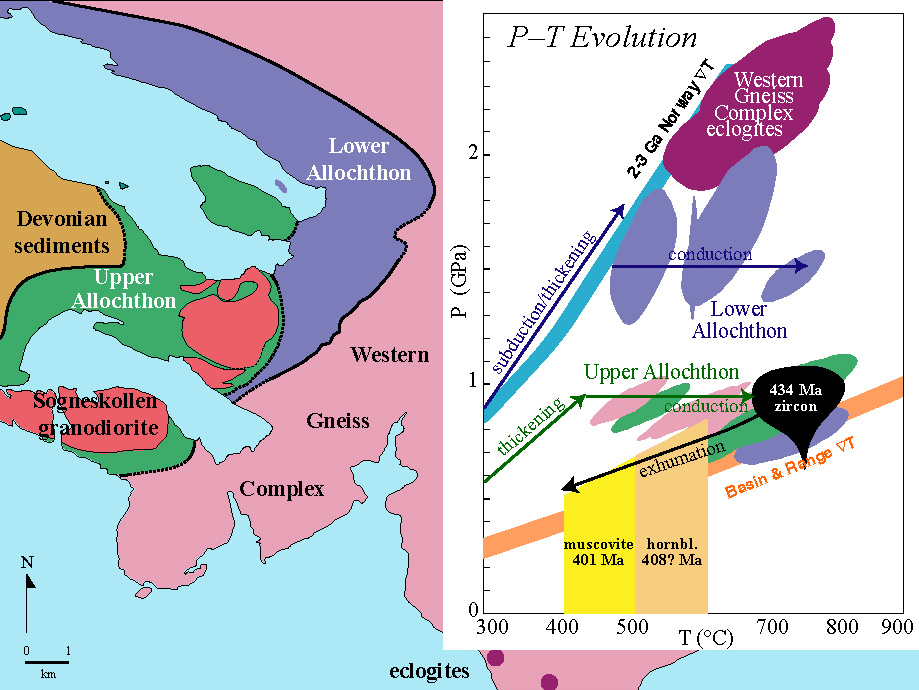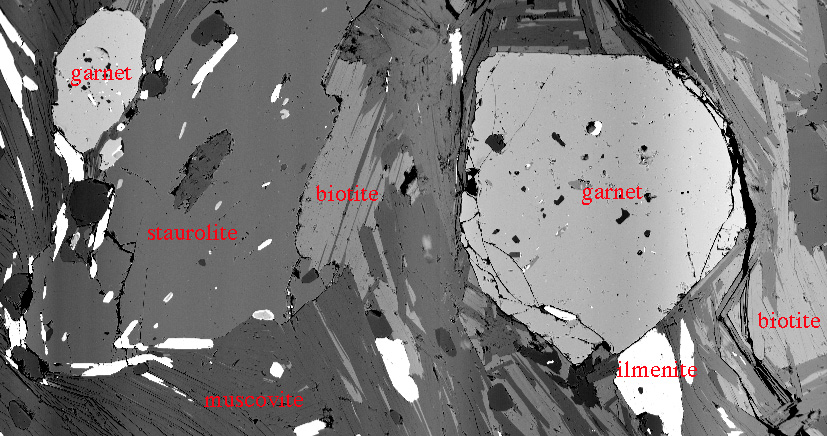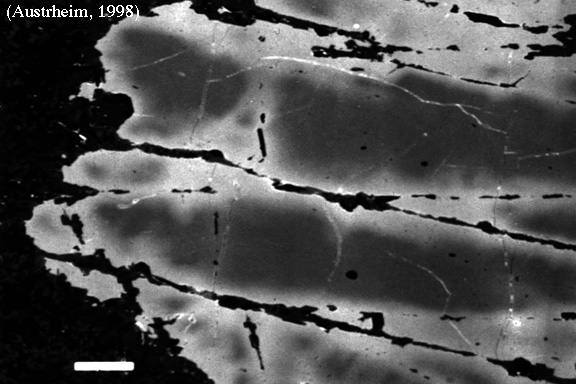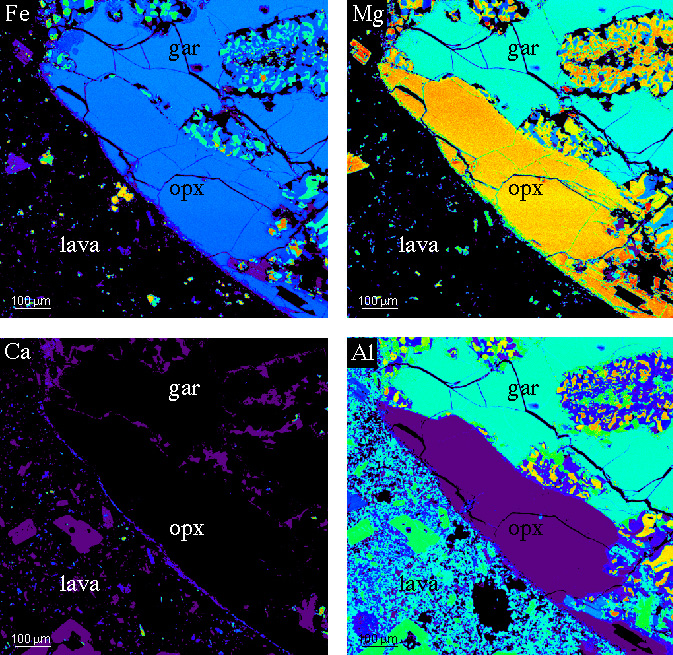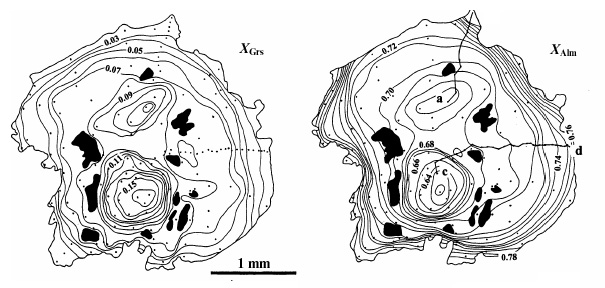 | Diffusion and thermodynamics |
Diffusion: mass transfer by the migration of point defects |
Diffusive mass transfer takes place in response to chemical potential gradients. For the purposes of this class, we will simplify this, and consider diffusion to occur in response to concentration gradients |
This equation tells us how fast the composition changes as a result of the diffusivity and the concentration gradient. For example, a concentration gradient that begins as a step function decays in the following manner -slope lows |
Diffusion Pathways |
volume diffusion: diffusion within a single grain. Volume diffusion only becomes significant at high temperature |
grain-boundary diffusion: diffusion along a grain boundary. Grain-boundary diffusion is orders of magnitude faster than volume diffusion, meaning that grain boundaries are the pathways by which material is transported through and within rocks of low porosity |
Metamorphic Effects of Diffusion, Kangmargar |
Garnet "KD9706g2" shows simple prograde zoning and simple shape |
Garnet "KD9791g1" shows complex zoning and shape. |
Garnet "KD9742bg2" shows more complex prograde zoning and zoning around inclusions |
These garnets show thin rims of plagioclase, likely related to decompression |
Pressures and temperatures of equilibration in lower crustal xenoliths from Tibet were constrained using compositions of garnet, pyroxene, and plagioclase |
One of the important goals of metamorphic petrologists is to reconstruct the P-T paths experienced by rocks. In general, this goal is attained by textural analysis combined with thermobarometry |
Back-scattered electron imaging is often a convenient and powerful way to study textures |
This back-scattered electron image shows zoning in garnet from a Norwegian eclogite |
Identification of zoning. Compositional zoning in minerals is best done by tuning the electron microprobe spectrometers to specific elements and then making element maps |
Zoning can be quantified over an entire grain with good coverage of spot analyses |
Source:http://www.geol.ucsb.edu/faculty/hacker/geo102C/lectures/part8.html
http://www.geol.ucsb.edu/faculty/hacker/geo102C/lectures/part9.html
Diffusion is the transfer of mass via the motion of individual atoms or molecules.
Diffusion within crystals is often discussed in terms of point defects, which are missing atoms (vacancies) or extra atoms in the crystal lattice. Every crystal has an equilibrium number of vacancies that allows the crystal to be in a lower free energy state than if it were perfect crystal-this is important because it means that crystals are always "ready to go" when it comes to diffusion.
diffusion: mass transfer by the migration of point defects
Diffusive mass transfer takes place in response to chemical potential gradients. For the purposes of this class, we will simplify this, and consider diffusion to occur in response to concentration gradients.
Diffusion Pathways
Different types of diffusion pathways include
intragranular (volume) diffusion
grain-boundary film (grain-boundary diffusion)
bulk fluid
grain-scale defects
Let''s examine three of these processes in more detail:
Aside from veins, metamorphic rocks have essentially zero porosity, such that diffusion through bulk fluids is not an important process except at shallow levels in the crust
volume diffusion: diffusion within a single grain. Volume diffusion only becomes significant at high temperature.
grain-boundary diffusion: diffusion along a grain boundary. Grain-boundary diffusion is orders of magnitude faster than volume diffusion, meaning that grain boundaries are the pathways by which material is transported through and within rocks of low porosity.
Metamorphic Effects of Diffusion
compositional zoning: Spatial variation in mineral composition results from slow volume diffusion (diffusion through the mineral lattice). In garnets, for example, diffusion of the divalent cations is negligible at low and medium grade, so that the interior of a garnet is isolated from the rock matrix, and as the P and T change, the garnet changes composition in response, and develops zoning. Garnets with prograde growth zoning tend to have Mn and/or Ca-rich cores, with Mg# increasing steadily toward the rim. Volume diffusion becomes fast enough at high grade for originally zoned garnets to become compositionally homogenized.
diffusional/retrograde zoning: zoning in which a pre-existing grain is modified in composition by exchange of material with the rock matrix. The usual result in a garnet is a grain with a depletion in Mg, and commonly also an enrichment in Mn, at the rim. This is found in garnets which have experienced temperatures >600░C.
THERMOBAROMETRY
Qualitative thermobarometry can be done simply by inspection of rocks and minerals in the field and in thin section, based on reaction textures and mineral assemblages. These garnets show thin rims of plagioclase, likely related to decompression.
Examples of P-T Determinations
Pressure-Temperature Paths
peak temperature: the maximum T experienced by a rock
peak pressure: the maximum P experienced by a rock
closure temperature: the maximum T recorded by a rock
closure pressure: the maximum P recorded by a rock
metamorphic field gradient: a spatially varying sequence of peak pressures and temperatures.
Quantitative Thermobarometry
More sophisticated, quantitative determination of metamorphic pressures and temperatures involves four steps:
careful assessment of reaction textures
identification of zoning
measurement of mineral compositions
application of thermodynamics.
1. Assessment of reaction textures. The purpose of this step is to identify which minerals are early, which are late, and which are part of a stable assemblage. Early minerals are likely to be inclusions or broken, late minerals may be in cracks or strain shadows, and minerals that are in textural equilibrium should not be separated by reaction zones. Back-scattered electron imaging is often a convenient and powerful way to study textures.
2. Identification of zoning. Compositional zoning in minerals is best done by tuning the electron microprobe spectrometers to specific elements and then making element maps.Such zoning can quantified using line scanning.
3. Application of thermodynamics. Experiments have been used to determine the PT positions of many different kinds of endmember reactions.
For example, experiments have shown that the distribution of Fe and Mg between garnet and biotite is a function of inverse temperature.
thermometry: The assessment of metamorphic temperatures.
Quantitative thermometry typically is based on the exchange of Fe and Mg between pairs of minerals. For example, the exchange of Fe and Mg between garnet and biotite can be written as a reaction among the Fe and Mg endmembers of these minerals:
Fe3Al2Si3O12 + KMg3AlSi3O10(OH)2 = Mg3Al2Si3O12 + KFe3AlSi3O10(OH)2
barometry: The assessment of metamorphic pressures.
Qualitative barometry is based on mineral assemblages-such as the coexistence of kyanite + staurolite.
Quantitative barometry typically is based on net transfer reactions
For example, garnet - aluminumsilicate - silica - plagioclase (GASP)
3CaAl2Si2O8 = Ca3Al2Si3O12 + 2Al2SiO5 + SiO2
Diffusion
Quantitative Geothermometry and Geobarometry
Thermodynamics

